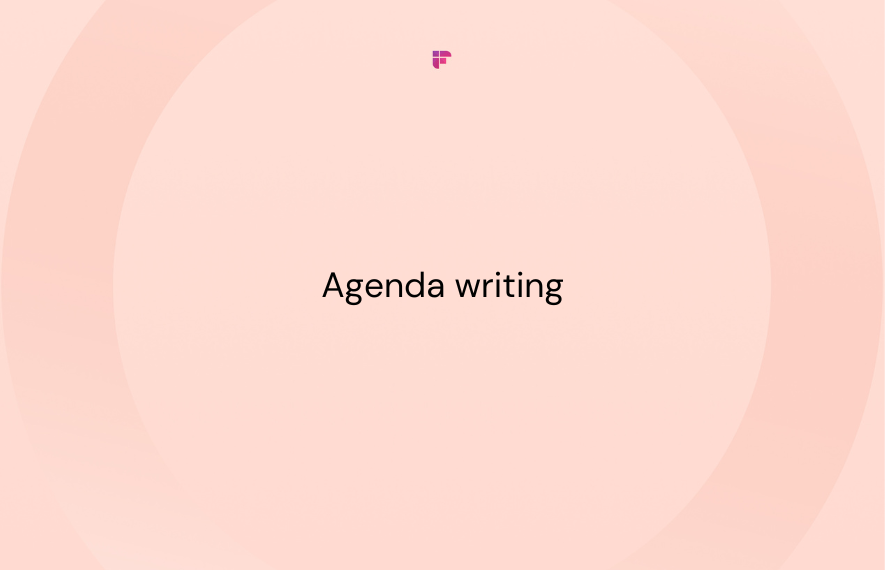Agenda writing has become one of the key skills that every professional must master to make their meetings more productive and efficient. In fact, a study by Hive found that a well-written agenda can decrease meeting time by up to 80%.
So how do you write an agenda for a meeting? In this blog, we'll discuss everything about:
- What is agenda writing?
- How to write an agenda?
- Agenda writing examples,
- 5 agenda writing tips, and more.
So read on to discover how to write an agenda like a pro!

What is agenda writing?
Agenda writing is the process of creating a detailed plan or outline for a meeting or other similar gathering. It involves carefully identifying the discussion topics, determining their order, and assigning time limits for each item on the agenda.
When writing an agenda for a meeting, your priority should always be to create a framework for productive discussion and decision-making. This can help you:
- Create a structure and direction for the meeting.
- Ensure the focus remains on the key topics and prevent unnecessary delays or deviations.
- Give prior clarity to the meeting participants about the topics covered and set their expectations straight.
- Define responsibilities and allow participants to come to the meeting prepared.
Overall, by writing an agenda for the meeting, you can have a focused, efficient, and productive discussion.

How to write an agenda?
You can follow different formats while writing an agenda for a meeting—bullet points, tables, or outlines. However, every meeting agenda must include the following:
- The main theme or objective
- The information on participants
- Time and venue of the meeting
- The topics to be discussed
- Time allotted for each topic
- The goals of the meeting
- Supporting documents—minutes of previous meetings, if any, reports, etc.
Now you know what to include, let’s look into the steps you must follow while writing an agenda for a meeting.
Step 1: Set up the document
First and foremost, set up a document for writing the agenda. The header of the document should include:
- Meeting title (type of meeting)
- Date
- Venue
- Meeting host/lead
- Participants
- Goals
Step 2: Define the purpose of the meeting
Once the framework is ready, establish the meeting type and clearly define the purpose of the meeting—whether it is a weekly sync-up or to discuss a specific topic.
Step 3: Organize the topics
The next step for agenda writing is to list the meeting topics one by one. Also, estimate how much time each topic will take and assign a specific time slot for each item on the agenda. This helps ensure that the meeting stays on schedule.
Step 4: Include the list of necessary documents
If any documents or reports need to be referred to before the meeting, include them with the agenda.
Also, add the documents you expect other participants to bring—project updates, daily reports, etc. This gives participants time to review or prepare the material before the meeting.
Step 5: Review, revise, and share
Now that the agenda-writing process is almost complete review the document once. You may also circle this around your colleagues or other participants and take their input.
This helps identify missed topics, if you need to extend the time for any topic, etc.
Once done, make necessary changes, if any, and finalize the document. Voila! Your meeting agenda is now ready to be shared.

Agenda writing examples
No explanation can match an example, so here are a few examples of agenda writing for you.
Writing agenda for a one-on-one meeting using the outline format
Follow the outline format for writing the agenda for a one-on-one meeting, as it gives more detailed instructions.

Writing agenda for a weekly sync-up using the bullet-list format
Let’s use a bullet point or listicle format to write a help agenda.
This format is straightforward, short, and crisp—the right fit for short meetings like project updates, weekly meetings, daily stand-ups, etc.

Writing agenda for a new project kickoff using the table format
For writing an agenda for a new project kickoff meeting, it’s best to follow the table format, where each column describes the topic, presenter, and time allotted. This format enables you to give meeting details in a crisper, more digestible form.
5 Agenda writing tips
Here are 5 agenda writing tips you need to follow:
- Seek inputs from your teammates and other participants
- Always leave room for questions
- Carefully curate the participants' list
- Use action-oriented language
- Identify and assign the right person to present each topic
1. Seek inputs from your teammates and other participants
After you’ve done writing a meeting agenda, reach out to team members and other participants and ask for their input. They may have unique perspectives or knowledge about the meeting's purpose, which can help identify important topics and prioritize them accordingly.
2. Always leave room for questions
You wouldn’t want any of these:
- Participants leave the meeting with a ton of questions in mind.
- People leave your meeting without clear action items.
- A 15-minute meeting went on for more than an hour because someone had questions.
So, always leave room for a Q&A session when writing an agenda for a meeting. This can not only facilitate problem-solving and active participation but also help reduce confusion or ambiguity around the points discussed.
3. Carefully curate the participants' list
In a survey by Cross River Therapy, 71% of employees spend half of their week attending meetings that are not directly related to them.
So, to save time and resources, carefully curate your participants’ list. Invite only those who are essential to achieving the meeting's goals. In fact, too many participants can only lead to detraction than productive discussions.

4. Use action-oriented language
When writing an agenda for a meeting, mention the goals as a list of actions rather than a list of procedures—focusing on outcomes rather than processes.
For example, instead of saying, "Discuss marketing campaign," say, "Develop marketing campaign strategy."
This helps set clear expectations on what actions will be taken during the meeting and what is expected of each participant and eliminates confusion.

5. Identify and assign the right person to present each topic
You wouldn’t want your Project Manager to speak about hiring updates. Sometimes, when roles are unclear, people tend to budge in presenting their views on matters they shouldn’t do.
So, while writing a meeting agenda, also mention who will present what. This clear definition of roles and responsibilities for each participant will keep the meeting on track and stay productive.
This way, you can also hold each participant accountable for their contributions and encourage active participation during the meeting.
BONUS TIP: Record, review, and share meeting summary
Remember the infamous Forgetting Curve? People will forget 50% of what you said within an hour. So, add to your agenda—share a memory aid with your fellow participants, the meeting notes.
Prepare and share the meeting notes for it. Ensure you include all the key points discussed, action items assigned, and any deadlines in the note.
💡 Fireflies Tip
But leading the discussion and taking notes in parallel can be a task. Let Fireflies help! Fireflies is a note-taking app that automatically transcribes, summarizes, and analyzes conversations with 90% accuracy.
Final thoughts
There it is, the ultimate crib note to ace your agenda-writing game. From what to include in an agenda to multiple examples and secret tips—all you need for writing an agenda for a meeting is here.
Remember, the key to a successful meeting lies in preparation, and a well-written agenda is its first step.
So go forth and write those agendas with confidence! Who knows, maybe someday you'll be known as the agenda master!








